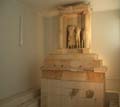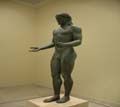
(31 Charilaou Trikoupi, Piraeus tel. 210 4521598, 210 3213122)
In the Archaeological Museum of Piraeus, the visitor comes into contact with the history of the city, which in ancient times enjoyed great prosperity both as a commercial center of the eastern Mediterranean and as a naval station of ancient Athens. The exhibits come mainly from the wider area of Piraeus and the Attic beach, and cover the Mycenaean to the Roman era. The museum's collections consist mainly of excavation finds or accidental finds and antiquities traditions, while in the basement are the workshops for the preservation of clay, metal and stone objects, as well as the museum's warehouse, where archaeological finds from the Piraeus area, the coastal zone are kept and the islands. There are also two notable private collections, the Meletopoulos-Nomidou Collection and the Geroulanos Collection. The main task of the museum is the collection, maintenance, recording and safekeeping of old and new mobile finds, which come from the wider area of Piraeus. Some of its activities are the organization of educational programs, as well as the gradual improvement of the building's infrastructure to better serve visitors.
FORECAST
A series of objects related to life and the main functions, both military and commercial, of the port are on display. In the same area, the important findings from the Minoan sanctuary on the summit of Kythera are presented.
1. CERAMICS HALL
Excavations of recent years from the area of the Attic beach and the Argosaronic islands are on display, covering a long period from the Mycenaean to the Hellenistic years. Of particular interest are the figurines of the Minoan sanctuary on the summit of Kythera, the votive offerings of the Mycenaean sanctuary of Methana and the rich collection of geometric and archaic vases from Salamis, Aegina, Vari and Trachones. The exhibition is complemented by a selection of classical period vases and small objects from private collections that have been donated from time to time to the Piraeus Museum.
2-3. HALLS OF BRONZE STATUES
The five bronze statues that were discovered in Piraeus in 1959 and are the jewel of the Museum are on display: the unique archaic kouros-Apollo, the two statues of Artemis, Athena of Piraeus and the tragic mask (4th century BC).
4. CYVEL HALL
Representation of a typical sanctuary of classical times: the naisco with the statue of Kyvelis from Moschato frames a series of votive reliefs from various sanctuaries of Piraeus.
5. HALL OF CLASSICAL EPITHAMS
A very important collection of marble epitaphs from the 5th and 4th centuries BC is on display which illustrate with characteristic examples the progress from the classical to the post-classical perception of the relief.
6. HALL OF LARGE BURIAL MONUMENTS
Two unique monuments from the period 350-330 BC are on display, the oversized stele of Pancharos and the mausoleum of an immigrant from Istria found in Kallithea. The giant lion from Moschato is similar.
7-8. RELIEF RELIEF HALLS
A series of Neo-Attic decorative reliefs that were intended for export to Rome and were the cargo of a ship that sunk in the port of Piraeus are on display.
9. HALL OF GREEK AND ROMAN ART
Brief presentation of ancient art from the end of the classical to the end of the Roman era. Poor, commensurate with the modern decline of the city, is the presence of Hellenistic and Roman sculptures, of which the colossal statue of Hadrian is of interest.
Editor: Fotini Anastasopoulou




































